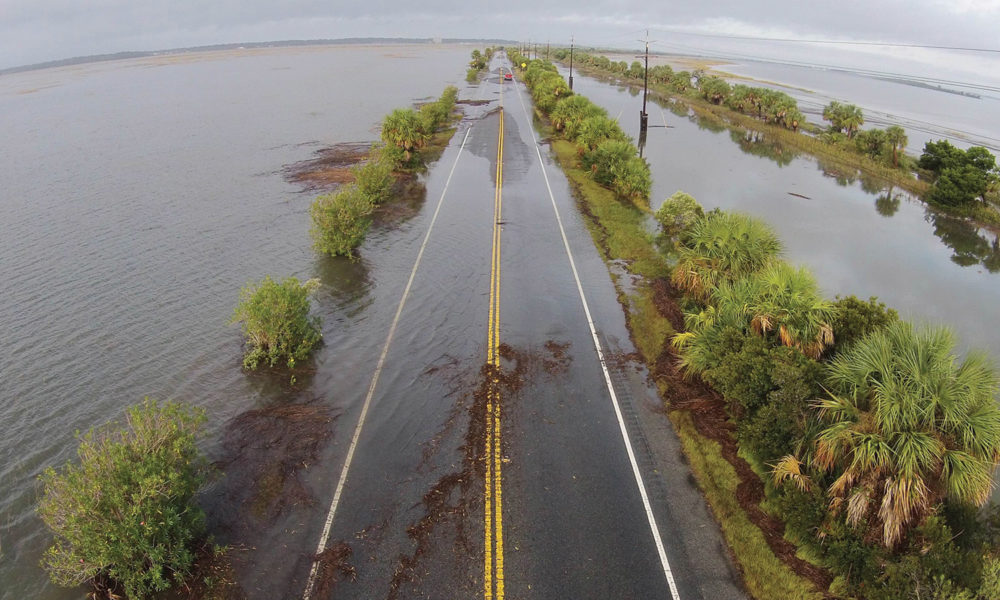This post was co-authored with Lara Hansen, Chief Scientist and Executive Director of EcoAdapt.
Last summer, one of us was locked inside their home in the Seattle area, not because of the pandemic, but because the air was full of smoke from fires raging hundreds of miles away in California. The other was peering through an orange afternoon haze for the same reason—thousands of miles away in Maine.
And sadly this was not the first year that a long, heartbreaking wildfire season has had hemispheric consequences, or that the impacts of human-caused climate change have cost lives and livelihoods in America. It was one of the worst, however. Climate impacts in the US cost our economy nearly $100 billion in 2020—almost double the previous year’s costs.
Over the past four years our country has been battered by the advancing impacts of climate change—fires, smoke, floods, droughts, storms, heat. These costly impacts are affecting our health, our homes, our jobs, our communities, and our natural heritage. At a time when climate change impacts have outstripped some of the most dire predictions, the Trump White House relaxed rules meant to slow warming and failed to act in any way to improve our ability to prepare. The inaction of the federal government at that critical time set our nation back in terms of readiness, resources, and resilience.
Much like the present year’s pandemic run amok, climate change was left unchecked with no coherent plan of response at the federal level. One of the reasons President Joe Biden was elected was because his team has a plan for addressing the causes of climate change. It includes rejoining the Paris Accord, addressing methane and CO2 emissions, and ensuring a just transition from fossil fuels to renewable energy as we “build back better.” Addressing the compounding impacts of climate change, however, requires a game plan that has not yet been fleshed out. To address the climate crisis we must restore past adaptation efforts, innovate new ones, and develop a national resilience strategy to organize and guide our efforts in the decades to come.
We need training across all sectors for people eager to understand how they can do their jobs differently in a changing world. We need to compile and share examples of how climate-savvy companies and communities have responded successfully to help others plan for the future. We need to fund and take actions that increase the durability of our frontline communities and communities of color. We need to work with the original inhabitants of our country to support Indigenous knowledge and help foster their resilience.
We need to invest in efforts to protect the forests, rangelands, rivers, and coasts that our economy depends upon. We need better access to the science that supports our decision-making and innovation. We need to change the way we do business in every facet of the economy, with an eye toward reducing risk, increasing resilience, and ensuring equity. And, as the Biden team has pledged to do, we need to invest heavily in climate-smart infrastructure to create jobs and reduce vulnerability to ongoing shocks and stresses. In other words, we need bold, transformational action and investment.
The good news is that we don’t need to start from scratch—and we shouldn’t. Over the past decades, individual communities, organizations, and government programs have been piloting the tools and solutions we need to meet those needs. But the actions of the previous administration over the past four years did nothing but scatter and weaken those resources.
Successful state and local efforts around the country, involving partners from across civil society, were constrained and isolated by lack of federal leadership and coordination. Federal agency programs that were providing climate science tools and advancing adaptation and resilience for frontline communities, Indigenous people, farmers, fishers, and land managers were shuttered, underfunded, or obliged to obfuscate their urgent mission. Outside the government, other entities tried to fill these gaps. For example, the United States hosts the largest adaptation database in the world, but it’s run by a small nonprofit on a shoestring.
For starters, we need to take stock of these existing assets and mobilize them as soon as possible by organizing them into a coordinated climate services infrastructure that serves communities, sectors, and ecosystems across America. At a time when public budgets are strained by the pandemic, this mobilization must be strategic and operate in concert with efforts to address the ongoing public health, social justice, and biodiversity crises. If we want to “build back better” these assets are our foundation.
Such an intersectional effort will require a national resilience strategy that establishes priorities and goals, promotes win-win solutions, and addresses difficult trade-offs. The strategy must feature measurable action steps necessary to reduce risk to our health and safety while safeguarding our natural resources. The strategy will require engagement at all scales and strong leadership from President Biden, who has indeed signaled his intent to focus on all aspects of the climate crisis.
We have lost time by failing to mobilize at the scale the climate crisis requires. Truth be told, we are not just four years behind where we need to be, we’re decades behind. It is imperative, for our economy, our lands, our cities and towns, and our children that we mobilize as we would for a national crisis. The obvious first step is to reinvigorate work that has come before, we have no time to lose by reinventing solutions. The scaffolding of a national resilience strategy will help guide investments and build on the existing capacity that was constructed in the years before the disastrous Trump administration. Let’s get serious about implementing what we’ve already spent time and money developing and testing, while innovating additional approaches to further shorten the pathway to resilience.
The suffering, death, and shocking economic loss caused by the disastrous wildfires, floods, and storms of 2020 reminded us that we have a long path ahead, a path down which we need to travel quickly for our country to thrive through dramatic change. By developing a national resilience strategy and scaling up existing efforts, we will be well on our way down that path to a climate-savvy future.

